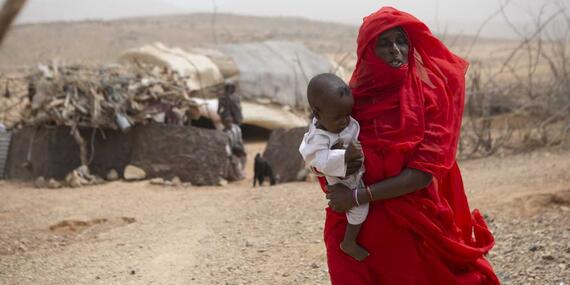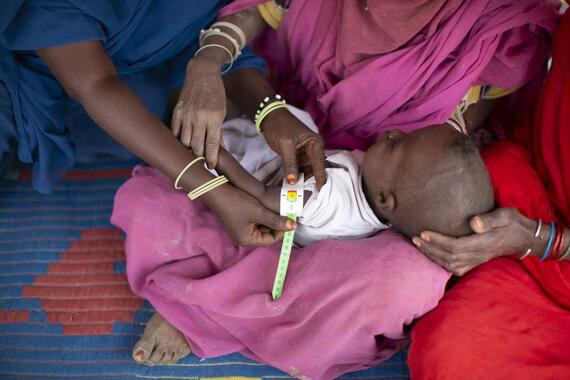Grandmother’s weekly hikes save grandson from malnutrition

Just after sunrise, 55-year-old Rahot lifts her one-year-old grandson, Hassan, onto her back to start a 20 km journey on foot through the mountain ranges of Red Sea state. Hassan has been suffering from severe acute malnutrition, a prevalent problem in the poverty- and drought-stricken region. But with his grandmother’s help, he is being treated at a health and nutrition centre managed by Save the Children International (SCI) and supported by the Sudan Humanitarian Fund (SHF).
Rahot remembers how worried the family was when they first noticed Hassan’s condition: “He was getting very sick, thin and frail; his health was deteriorating,” she explained. “We used to live in a village even further away. Through word of mouth, we heard about the nutrition services here. We decided to move to a village nearer to the facility, to make it easier to take him there. My daughter, Fatima, stays with her four other children and I bring him to the centre.”
Hassan was only 12 months old when he was admitted for treatment at the centre implemented by SCI. At the time, his mid-upper arm circumference (MUAC), a measurement used to identify nutrition problems, was 10.2 cm, signifying severe acute malnutrition. He weighed only 5.7 kg and was 65.5 cm tall. The centre immediately enrolled Hassan into a programme to receive nutritious, ready-to-use therapeutic food.
The family explained that they usually do not have enough money to buy food for their children. Hassan’s father went to Port Sudan, the state capital, to earn money, but like many others who left to find work, he sends money only every few months, which is not enough to cover all the children’s needs.
In recent years, rainfall has been scarce in Red Sea state, reducing the grazing for livestock. Animals are now used only for limited milk production, which is often insufficient. The basic diet consists of plain, starch-based food, offering little to no nutritional value.
“We eat kissra (sour flatbread) and aseeda (local porridge) every day,” Rahot explains. “We don’t eat anything else. Also, there are few water sources, and they are far away and not always clean.”
Driven by the economic crisis and climate change, hunger is rising in Red Sea state. Last year in particular, rains were less than previous years, heavily affecting crop production and access to drinking water for people and livestock, and considerably reducing livestock’s access to fodder.
According to the Integrated Food Security Phase Classification data, more than a third of the state’s population will experience crisis and emergency levels of hunger during this year’s lean period (June to September). This means that many families will revert to negative coping mechanisms, such as marrying off their children early, sending children to work, or simply reducing the amount and variety of food to unhealthy levels.
Hunger, especially in early childhood, has long-term impacts on children’s health and development: apart from the increased mortality risk, it can lead to delayed growth and physical disability. It is also associated with cognitive and behavioural disorders in children, particularly when it occurs during early childhood.

Rahot and her family are relieved that Hassan’s health has significantly improved through the centre’s support: four months into his treatment, and with his grandmother’s consistent commitment, Hassan’s MUAC went from red to yellow, measuring 12 cm. This indicates moderate acute malnutrition and is a major sign of recovery.
Rahot is still dedicated to continuing the weekly roundtrip to the centre: “I don’t want to miss any of his appointments,” she said. “I want to see him getting bigger and older, and I want to see him become an educated man. The team in the centre also explains to us which foods are healthy for children and how to feed them in a balanced way.”
Hassan now weighs around 7 kg and is 70 cm tall. Although his health has improved considerably, he will continue receiving supplementary feeding until he is fully recovered.
The nutrition activities are funded through a multisectoral project funded by SHF, which started in December 2021, covering health, nutrition, child protection, and water, sanitation and hygiene interventions. Additional funds were received in May 2022 for nutrition activities to address the increasing needs.
To continue these activities, SCI received an additional US$2 million in August 2022 through the Standard Allocation, including an additional education component.
